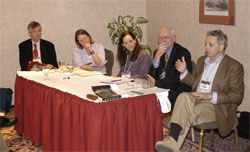Diversity Is the Theme at AERA
TC presentations range in topics but highlight inclusion
It's the world's foremost gathering of education researchers (12,000 from 53 countries), and its theme this year was "Demography and Democracy in the Era of Accountability." So it's not surprising that the 2005 annual meeting of the American Educational Research Association (AERA), held in Montreal in early April, drew more than 162 presenters, panel participants and session chairs from Teachers College alone.
The titles of their talks ranged from "'God Doesn't Wear a Baseball Cap': Exploring Children's Spiritual Experience Through Picture Books," by Frances Schoonmaker, Professor of Education, to "The Dissertation and Graduation: Not Just a Black and White Process," by Felicia Moore, Assistant Professor of Science Education, to "The Effect of Problem Type on Collaborative Problem-Solving in a Synchronous Computer-Mediated Environment," by Charles Kinzer, Professor of Education. But all shared a common focus on inclusiveness, or barriers thereto.
"Learning environments could be even more powerful if they addressed the need to help teachers and students develop cultural and personal knowledge of one another and of the content they are studying," said Xiaodong Lin, Associate Professor of Technology and Education, who, along with her graduate student, Huang Yao Hong, spoke on "People Knowledge: A Useful Ingredient for Bridging Cultural Differences Between Teachers and Students." Lin's thesis is that while general knowledge of another person's culture - political system, food, customs, holidays, historical events - is always useful, better classroom instruction occurs when teachers and students have specific "people knowledge" of one another. For students, in particular, such knowledge has strong emotional and cognitive effects on their understanding of the material being taught.
"American classrooms increasingly pair foreign students with a domestic teacher, and vice versa," Lin says. "So if a student can understand why a teacher focuses on a particular aspect of teaching and learning, and a teacher understands why a student learns in a particular way and how his or her cultural upbringing has contributed to ways of living and thinking, the cultural gap between the two can be reduced."
In a presentation titled "The Sociolinguistic Landscape of New York City Schools," Ofelia Garcia, Professor of Bilingual Education, and her TC colleague, Leslie Bartlett, Assistant Professor of Education, focused on Gregorio Luperon High School in the Washington Heights neighborhood of Manhattan - the city's only institution that exclusively serves Latino students who are newly arrived in the United States. Courses are conducted in Spanish, with intensive teaching of English as a Second Language.
"There's been a lot of controversy about a school that's segregated according to a single language," Garcia says, but adds that the study -- part of a broader project by Bartlett on newcomer Latino students in and out of school -- has found that Luperon is highly successful in ultimately integrating its students into American life.
"The instruction is rigorous," Garcia says, "The kids pass their Regents with scores above the citywide averages, and most of them go on to four-year colleges."
A group of students and faculty led by Kikumi Tatsuoka, Distinguished Research Professor, and Jim Corter, Associate Professor of Statistics and Education, presented findings from analyses they have been conducting for the past four years of data from the Third International Mathematics and Science Study-Revised (TIMMS-R), which assessed the math performance of eighth graders in countries around the world. The group, which included Human Development doctoral students and former students Michael Dean, Enis Dogan, Eun Kyoung Um, Tomoko Yamada, Seongah Im and Anabelle Guerrero, has employed an analytical method called the Rule Space Model, the leading model for cognitive diagnostic mathematics tests (those that tease out students' "sub-skills), developed by Tatsuoka, a former Principal Research Scientist at Educational Testing Service. Using this method, Tatsuoka and Corter's group has been able to identify differing patterns of achievement for the countries whose students posted the highest TIMMS-R scores. For example, in Hong Kong, eighth-grade students were especially proficient in content knowledge, while Japanese students scored higher on problem-solving ability. American eighth-grade students were strong on quantitative reading (the ability to understand and solve mathematical problems posed in text form), but weak in geometry - "partly because of how we order our curriculum, but perhaps partly because of our lack of emphasis on visual methods," Corter says.
One presentation by Corter's group found that intrinsic motivation, rather than external motivation, positively influenced students' math performance on TIMMS-R; that students with a positive "math self-concept" do better, and that supporting students' autonomy in the classroom also positively affects their math performance.
Rob Horowitz, Adjunct Associate Professor of Music and Music education, and Associate Director of TC's Center for Arts Education Research, presented the results of a seven-year study of how to assess the academic impact of arts education programs. Horowitz looked at four New York City elementary schools that have created artist-in-residence programs through an organization called ArtsConnection.
"In this era of accountability, there is increasing pressure on arts programs to demonstrate that they are effective in improving academic performance," Horowitz says. "We grappled with this issue head-on. Through analysis of classroom observations and interviews, we came up with over 3,000 possible rating scale items, measuring aspects of partnership, teacher/artist collaborations and student development in cognitive, social and personal domains. We found significant relationships between the ability of teachers to effectively collaborate with artists and develop their confidence in using arts in the classroom, on the one hand, and children's development of elaborative thinking, motivation to learn, self-confidence and a sense of ownership in the learning process. We think the study presents a good antidote to the requirements of No Child Left Behind, which favors standardized testing in subjects unrelated to the arts."
Next up: the 2006 AERA meeting in San
Francisco. The topic: Education Research in the Public Interest. The
prediction: TC will be well-represented - again.
Published Tuesday, May. 31, 2005
